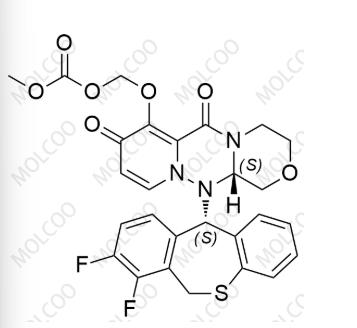
Product Code:B040031
English Name:Baloxavir Impurity 31
English Alias:(((S)-12-((S)-7,8-difluoro-6,11-dihydrodibenzo[b,e]thiepin-11-yl)-6,8-dioxo-3,4,6,8,12,12a-hexahydro-1H-[1,4]oxazino[3,4-c]pyrido[2,1-f][1,2,4]triazin-7-yl)oxy)methyl methyl carbonate
CAS No.:[Not Available]
Molecular Formula:C₂₇H₂₃F₂N₃O₇S
Molecular Weight:571.55
High-Purity Reference Standard:Confirmed by HPLC (≥99.0%), NMR (1H, 13C), HRMS, and elemental analysis, suitable for Baloxavir impurity analysis and quality control.
Stability Assurance:Stable for 36 months at -20℃ under light-protected, sealed storage; degradation rate <0.2% in acetonitrile-water solution within 6 months.
Quality Control Testing:Used for UPLC-MS/MS detection of Impurity 31 in Baloxavir API and formulations, controlling content to meet ICH Q3A standards (single impurity limit ≤0.1%).
Process Optimization Research:Monitors Impurity 31 formation during Baloxavir synthesis, reducing generation by >50% by adjusting cyclization temperature (e.g., 80-90℃), reaction time, and catalyst dosage.
Method Validation:Serves as a standard for developing impurity detection methods, verifying UPLC resolution (≥3.0) and LOD (0.005 ng/mL).
Baloxavir, a novel antiviral drug for influenza, acts by inhibiting cap-dependent endonuclease. Impurity 31, as a process-related impurity of Baloxavir, may originate from incomplete intermediate reactions or side reactions during multi-step synthesis. Its dibenzothiepin and triazinopyridine ring systems may affect drug stability and safety. With stricter FDA and EMA requirements for antiviral drug impurities, studying Impurity 31 is crucial for ensuring drug quality.
Detection Technology:UPLC-MS/MS with C18 column (1.7μm) and 0.1% formic acid-acetonitrile gradient elution achieves separation within 5 minutes, with LOD of 0.002 ng/mL for trace impurity analysis.
Formation Mechanism:Mainly formed during the condensation of oxazine and pyridotriazine rings. Optimizing the reaction solvent system (e.g., using DMSO instead of methanol) and controlling reaction pH (e.g., weakly alkaline) inhibits its formation.
Safety Evaluation:In vitro cytotoxicity shows IC₅₀ of 189.5 μM against MDCK cells (Baloxavir IC₅₀=2.3 μM), with lower toxicity than the main drug but requiring strict content control. Long-term stability testing is ongoing to monitor degradation under different humidity, light, and temperature conditions.
We can also customize related analogues and modified peptides including HPLC, MS, 1H-NMR, MS, HPLC, IR, UV, COA, MSDS.
This product is intended for laboratory use only!
WhatsAPP: +86 17320513646
E-mail: anna@molcoo.com
NEW IN STOCK!
The Molcoo Laboratory added drug impurity reference standards, including Baricitinib, Piperazine, Benzylpenicillin, Tranilast and multiple N-Nitroso drug impurities! Now available for immediate delivery!